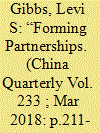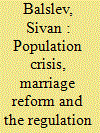| Srl | Item |
| 1 |
ID:
159832


|
|
|
|
|
| Summary/Abstract |
Shortly after a push to promote China's 1950 Marriage Law in 1953, scholars from the Chinese Music Research Institute on a collection trip to a small locality in northern China encountered a large number of folksongs about extramarital affairs. They interpreted this as evidence of the need for marriage reform. The folksong lyrics highlighted controversial aspects of the Marriage Law by espousing one of the law's central tenets – free love – while also expressing women's desires to leave their husbands. In this article, I explore how the researchers placed the song lyrics in a liminal moral-temporal category between “feudal” arranged marriage and the new marriage system before declaring the songs to be relics of the victimization of women in a “feudal” past. I argue that additional light-hearted elements complicate the researchers’ conclusion and suggest that when the promotion of social agendas in the 1940s and 1950s cast songs about illicit affairs as morally ambiguous, Chinese scholars chose to ascribe the songs’ “roots” to other groups or to the “feudal” past of the people they sought to praise and/or transform.
|
|
|
|
|
|
|
|
|
|
|
|
|
|
|
|
| 2 |
ID:
159222


|
|
|
|
|
| Summary/Abstract |
Beginning in the early twentieth century, a discourse on population crisis emerged in the Iranian press. Iran, it was argued, suffered from a small and sickly population, and therefore was unable to fully exploit its natural riches and resources. One suggested solution to the problem was a reformation of the traditional model of marriage, making monogamous, age-appropriate marriage the new norm. This was to provide Iran with numerous robust future citizens, the result of healthy and suitable couples. The article presents the process in which fear of population decline led to a change in the perceptions of ‘proper’ male sexuality, of married life and of love in Iran. It shows how this process influenced gender relations and social relations, preserving women’s subjugation within companionate marriage and constructing men of social groups who practised polygamy and child marriage as corrupt and unpatriotic, unlike Western-educated elite men who adopted companionate marriage.
|
|
|
|
|
|
|
|
|
|
|
|
|
|
|
|